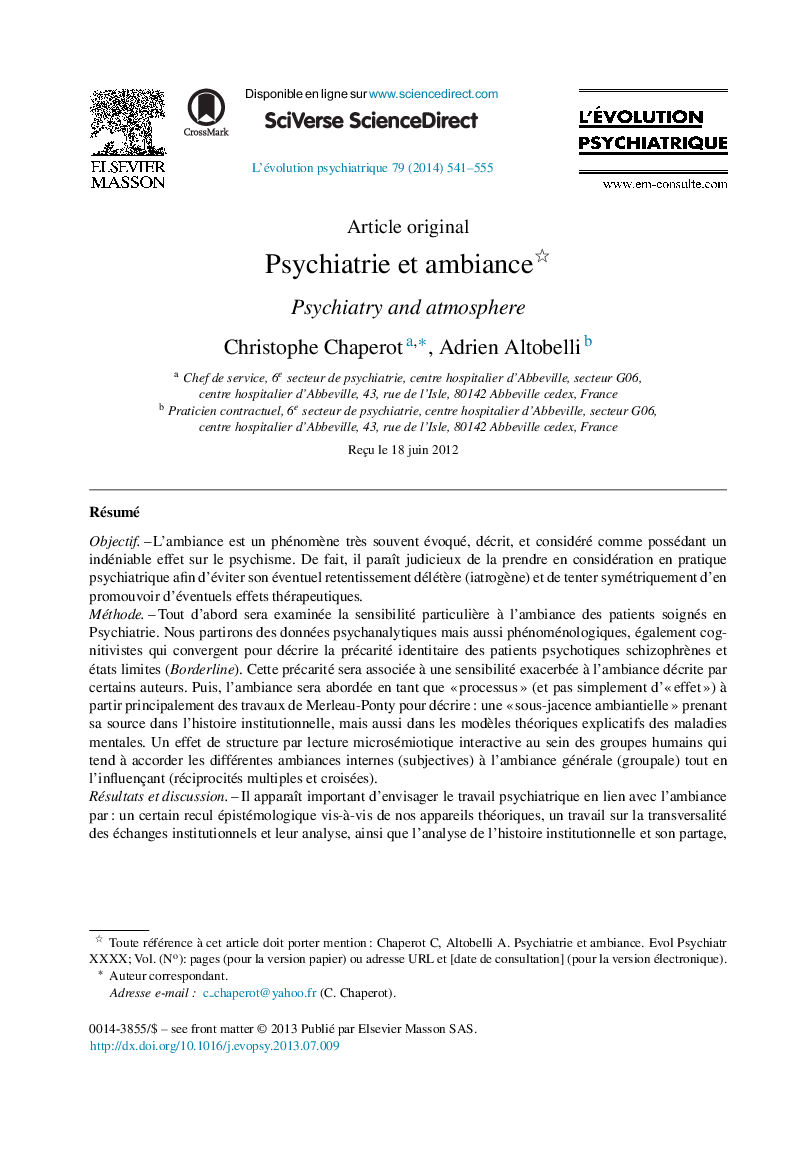| کد مقاله | کد نشریه | سال انتشار | مقاله انگلیسی | نسخه تمام متن |
|---|---|---|---|---|
| 908489 | 917180 | 2014 | 15 صفحه PDF | دانلود رایگان |

RésuméObjectifL’ambiance est un phénomène très souvent évoqué, décrit, et considéré comme possédant un indéniable effet sur le psychisme. De fait, il paraît judicieux de la prendre en considération en pratique psychiatrique afin d’éviter son éventuel retentissement délétère (iatrogène) et de tenter symétriquement d’en promouvoir d’éventuels effets thérapeutiques.MéthodeTout d’abord sera examinée la sensibilité particulière à l’ambiance des patients soignés en Psychiatrie. Nous partirons des données psychanalytiques mais aussi phénoménologiques, également cognitivistes qui convergent pour décrire la précarité identitaire des patients psychotiques schizophrènes et états limites (Borderline). Cette précarité sera associée à une sensibilité exacerbée à l’ambiance décrite par certains auteurs. Puis, l’ambiance sera abordée en tant que « processus » (et pas simplement d’« effet ») à partir principalement des travaux de Merleau-Ponty pour décrire : une « sous-jacence ambiantielle » prenant sa source dans l’histoire institutionnelle, mais aussi dans les modèles théoriques explicatifs des maladies mentales. Un effet de structure par lecture microsémiotique interactive au sein des groupes humains qui tend à accorder les différentes ambiances internes (subjectives) à l’ambiance générale (groupale) tout en l’influençant (réciprocités multiples et croisées).Résultats et discussionIl apparaît important d’envisager le travail psychiatrique en lien avec l’ambiance par : un certain recul épistémologique vis-à-vis de nos appareils théoriques, un travail sur la transversalité des échanges institutionnels et leur analyse, ainsi que l’analyse de l’histoire institutionnelle et son partage, une conception de la personne saine ou malade reposant sur un socle commun de l’être au monde (déstigmatisation de principe).
ObjectivesThe general phenomenon of “atmosphere” (or mood or stimmung) has an undeniable effect on the mind that can strongly influence its functioning. Consequently, it would appear judicial to study the ‘atmosphere’ as a therapeutic or potentially iatrogenic process in psychiatric institutions. The analysis of this process could open pathways for the overall organisation of psychiatric care.MethodThe basic method of this work consists in crosschecking various fundamental works in varying fields such as phenomenological philosophy, (Heidegger, Merleau-Ponty, etc.), existential analysis (Maldiney, etc.), modern architecture, institutional psychotherapy (Oury, Tosquelles), and psychoanalysis (different French and Anglo-Saxon schools). We will recall the relationship between the concept of atmosphere and psychiatry from a historical point of view, in two aspects. To start with, the quality of the contact with the atmosphere defined depending on the pathology (projection in the atmosphere, asyntony, etc.) followed by an overview of the notion of early diagnosis (or almost instantaneous) by the psychiatrist based on the relational mood with his/her patient. This will be followed by a review of the literature that will show that almost all the authors describe the hypersensitivity to the mood of psychotic, schizophrenic, or borderline patients. The mood directly affects the patients’ mental health and is decisive in orienting the care towards an obvious improvement, but also more often towards major worsening. The intrinsic and specific characteristics of the atmosphere will then be examined and based principally on modern architectural works (principal organisers of the atmosphere of a place, a space, or a town). The atmosphere will appear to be undividable, immediate, omnipresent and diffuse. We will insist on the performative notion of a transformation of the mood through its verbalisation and a verbalisation influenced by the mood itself, with a continuous reflecting effect. We propose an atmosphere composed of immediate unconscious microsemiotic interactions composing a dialectic ‘structure’. We will use the notion of “subjacency” (Oury) to describe the subconscious grouped historical strata of an institution and their direct action in the form of an atmosphere together with the ‘cleavage’ mechanisms that, in majority, prevail. The influence of care theories and ‘circulating knowledge’ on the joint therapist-patient atmosphere will also be analysed. Finally, the deleterious iatrogenic effects will be discussed (pathoplasty, Oury): senility and acting out.ResultsMood appears as an essential process in psychiatric care, its description and analysis can, at least in part, guard against iatrogeny.DiscussionThe institutional work on atmosphere is based on its constant analysis and transversal description within the group of therapists, and if possible within the therapist-patient group. Mood influences its verbalisation and its verbalisation changes it. Analysis of the institutional but also theoretical historical ‘subjacencies’ would appear decisive in the attempt to avoid a iatrogenic atmosphere. And, over and above the battle against iatrogeny, the general ‘mood’ would represent an essential therapeutic lever. We propose that the fact that the carers (therapists) come to terms with the artificiality related to their simple ‘existence’ (Dasein), an essential dimension shared by any sane or sick person that leads to a form of ‘connivance’ allowing the opening of a “space of therapeutic atmosphere”.ConclusionThe atmosphere is a fundamental element of the treatment of psychiatric patients, which must be considered with more attention than is generally given to it. Even if its ‘handling’ remains extremely difficult, borrowing more from human qualities of the one and the other, than from a precise medical protocol, it must be one of the priorities of the work in psychiatric institutions.
Journal: L'Évolution Psychiatrique - Volume 79, Issue 3, July–September 2014, Pages 541–555